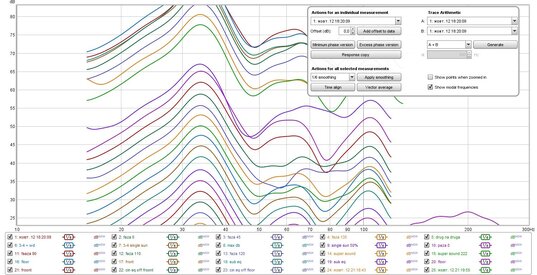Marc Lombardi
Member
- Joined
- Apr 14, 2018
- Posts
- 68
More
- Preamp, Processor or Receiver
- Emotiva XMC-1
- Main Amp
- Nord One 2x700w
- Additional Amp
- Outlaw 7500 5x300w
- Other Amp
- Emotiva PA-1 300w
- Universal / Blu-ray / CD Player
- OPPO-205
- Front Speakers
- Magneplanar 3.7
- Center Channel Speaker
- Magneplanar CC5
- Surround Speakers
- Magneplanar MC1
- Surround Back Speakers
- Polk Dipole
- Subwoofers
- Outlaw Ultra X-12 and LFM1-C; Magneplanar DWM
- Other Speakers
- MiniDSP 2x4
Sorry, Sonnie, maybe I spoke too broadly or maybe there are two different things going on. But you made me think, and that's always good! :-) If you have measured different response with subs in a given location with the only difference being orientation, that's really interesting. Do you get smoothing of peaks and nulls? Assuming "side-firing" sub design of course .... and I assume a sub designed to fire into the room would not have predictable results if turned downward or pushed up against the wall, and similarly for one designed to fire downward.
I was referring to the principle that lowest frequencies are omnidirectional below the point where the radiating surface diameter is small with respect to the wavelength (i.e. a 12" driver vs 14ft wavelength @80Hz, 28ft wavelength @40Hz, etc). And so I wonder if radiation is omnidirectional, what difference could it make in which direction the radiating surface is pointing? I took a quick look back at writings of Toole and Welti (Harman) and only found one reference to the direction of the sub. The simulations and measurements that Welti wrote about in his paper did not mention orientation, only position. Welti said in an interview that if the driver was "too close" to the wall it could affect acoustic loading, but not much.
I was referring to the principle that lowest frequencies are omnidirectional below the point where the radiating surface diameter is small with respect to the wavelength (i.e. a 12" driver vs 14ft wavelength @80Hz, 28ft wavelength @40Hz, etc). And so I wonder if radiation is omnidirectional, what difference could it make in which direction the radiating surface is pointing? I took a quick look back at writings of Toole and Welti (Harman) and only found one reference to the direction of the sub. The simulations and measurements that Welti wrote about in his paper did not mention orientation, only position. Welti said in an interview that if the driver was "too close" to the wall it could affect acoustic loading, but not much.










